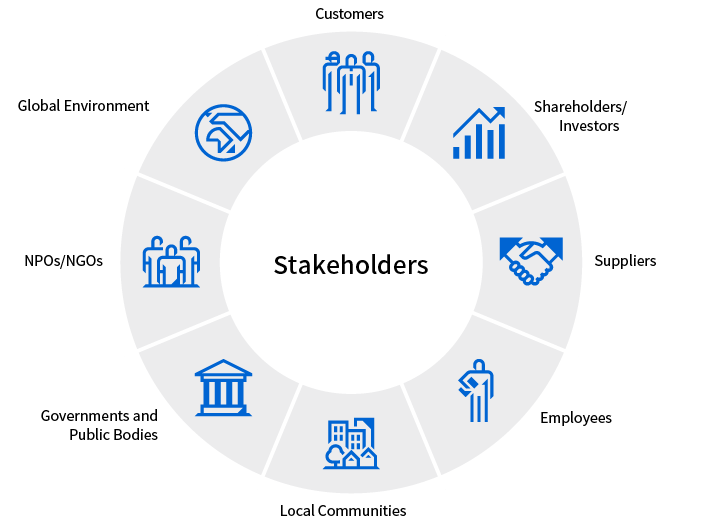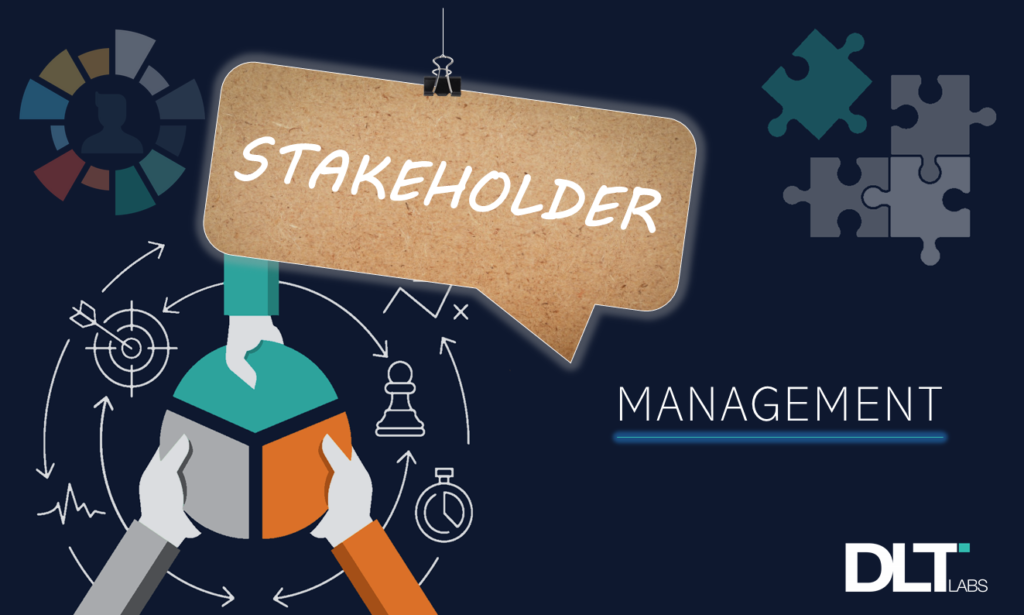
Introduction to Stakeholders in Business
A stakeholder is a person, group, or organisation having a stake in the organisation, either financially or otherwise. This is a stake, either direct or indirect. Some of an organization’s key stakeholders include its employees, directors, creditors, suppliers, owners, customers, the government, and the general public.
There is a two-way communication between the organisation and the stakeholder. On the one hand, the stakeholder may affect the organization’s decisions, policies, practises, and activities; on the other hand, they are also affected by these factors.
Therefore, one definition of a stakeholder is “a person, a group, or an organisation that is influenced by or impacts the company’s operations, policies, or objectives.”
An organization’s product marketing has an impact on a variety of stakeholders, including customers (better products), employees (higher salaries, incentives), suppliers (orders for raw materials, packaging), creditors (credit for the organization’s growth plans), owners (returns on equity), the government (increased corporate taxation revenue), and others.
An organization’s stakeholders all have distinct objectives. The top management of the company is relied upon by stakeholders to maximise earnings. The management of the company often has to find a balance between fulfilling the needs of the company and maximising returns to stakeholders.
Stakeholders, for instance, are motivated to maximise the dividends, bonuses, salaries, and incentives they get in exchange for their investment. The leadership, on the other hand, would like to spend more money on the research and development division, which would increase the company’s productivity and prepare it for the future.
To do this, stakeholders will have to give up some short-term rewards. The company’s leadership must find a balance between the organization’s long-term investments and its short-term benefits to stakeholders.
According to Bisset, “a stakeholder is a person who is interested in or concerned about a certain issue.”
According to R. Edward Freeman, “A stakeholder in an organisation is (by definition) any group or individual who may influence or be impacted by the fulfilment of the organization’s objectives.”
Post, Preston, and Sachs define stakeholders as “persons and constituencies that contribute, either willingly or involuntarily, to a company’ wealth-creating skills and activities, and who, as a result, are its potential beneficiaries and risk bearers.”
Roles of Stakeholders in Strategic Management

1) Voting and Decision-Making: By voting on various issues, stakeholders may significantly influence the organization’s direction. The decision-making and voting procedure, which occurs annually or at a meeting, is open to stakeholders.
The management of the firm, which is in charge of formulating the company’s strategy and making decisions, is subject to influence from stakeholders. If the organisation is not working effectively, stakeholders, such as the Board of Directors, may step in and make the necessary modifications and develop appropriate initiatives.
2) Positions in Managing and Supervising the Organization: Stakeholders may also be important members of management who directly affect the operations and policies of the company. They could be directly answerable to the director, CEO, or CFO of the business.
Check here for latest case studies and research book : https://kit.co/Anurooba/case-analysis-text-books
Since their actions may affect the performance of a certain department within the organisation, managers of multiple departments may be stakeholders. Additionally, they could be in responsible of recruiting, training, and informing their departments of changes to organization-wide policy.
3) Meeting Social and Environmental Responsibilities: Because businesses are a part of society, they have social responsibilities. The interests of society and the environment must not be jeopardised by the organization’s strategy, policies, or operations, according to stakeholders. This might take many different shapes. Stakeholders may choose to switch to another energy source if the current one runs out.
They could also decide to donate money to a worthwhile cause or a country that deserves it. The public good should be a company’s main motive in addition to its own self-interest. Stakeholders have a moral responsibility to ensure that the corporation puts the interests of society above their own interests.
4) Project Planning: The project planning process involves active participation from stakeholders. The project planning process includes determining the project’s objectives, outlining and allocating resources, selecting project methods, analysing significant events, and ultimately evaluating the results. Stakeholder participation in project planning enhances the transparency of the project and its process.
Classification of Stakeholders

Based on their relationship with the organisation, stakeholders may be categorised into two groups:
1) Internal Stakeholders
2)External Stakeholders
Internal Stakeholders
Individuals that work for or interact directly with an organisation are considered internal stakeholders. Some of the most significant internal stakeholders are listed below:
1) Shareholders: Shareholders are individuals or entities that own equity in the corporation. They are referred to as “business owners” as a consequence. Shareholders are treated the same as other employees and partners in the business.
These investors contributed money to the business in order to aid it in achieving its objectives. The company’s main responsibility is to look out for the interests of its shareholders. Shareholders get a portion of the profits as compensation for their investments.
2) Workers/Employees: People who work for a corporation and expect payment, benefits, and security in return are known as employees. The arrangement between employees and the firm is governed by the employment contract. Employees donate their time and effort to the firm, which places certain obligations on the business.
Now it is up to the company to honour its commitments to its employees. One of the organization’s main responsibilities is to treat employees with respect and acknowledge their value as a resource for achieving organisational goals.
3) Management: The management of an organisation affects both the company and external stakeholders. A written or verbal agreement exists between management and the organisation.
The main responsibility of management is to ensure that an organization’s operations function smoothly and to create strategies for its long-term success. The task of balancing the rights of the many stakeholders falls to management.
External Stakeholders
External stakeholders are individuals, groups, or businesses that are not affiliated with the organisation yet have indirect interactions with it. be able to influence External stakeholders may be impacted by organisational changes. Some of the most significant external stakeholders include: the
1) Customers: Customers, also known as consumers, are people or organisations who purchase things from a firm. Customers are thus one of a company’s most crucial revenue streams. Since these funds are reinvested in many aspects of the business operations, customers are the main asset indirectly involved in the creation of new products and services.
By purchasing the company’s products and fostering positive word-of-mouth, they boost sales for the company. As a consequence, ensuring customer satisfaction is one of an organization’s most important long-term goals.
2) Suppliers: Suppliers are individuals or business owners that give raw materials or semifinished goods to the organisation for use in the final production process. Distributors are service companies that deliver finished goods to their customers.
The materials supplied by the suppliers determine the final product’s quality and value. As a consequence, the company should exercise vigilance in its business dealings with suppliers. In order to lower production costs while boosting efficiency and quality, the firm must build strong connections with its suppliers.
3) Creditors: Companies that provide raw materials or semi-finished goods to an organisation on credit are known as creditors.
Given that a strong connection between the business and its suppliers is one of the most essential drivers of success, the company runs the danger of losing its competitive edge if it does not pay the proper amount on time. In the case of dissatisfaction, suppliers may harm a company’s business by ceasing to operate or by providing subpar goods.
4) Competitors: The organisation is grateful to its rivals in the same way as it is to its stakeholders. Any company’s competitive strategy might either benefit or hurt its competitors’ businesses and vice versa. As a consequence, a business must always exercise ethical vigilance in order to compete in a cutthroat market.
5) Government: By passing various laws and establishing restrictions, the government regulates the acts and policies of organisations. Compliance with the laws and rules that govern an organization’s activities is one of its main responsibilities. Planning should take into account how the government will execute its legislation.
Management may be impacted by taxes, laws, and obligations imposed on the company, and management may also be impacted by them. By using fair trade practises, paying taxes on time, and abstaining from abusive trade practices, management may help the government.
6) Society/Community: The society or community in which the organisation works has an impact on its operations. The management is responsible for educating and enlightening society as well as ensuring its welfare by raising the standard of living in general. Organizations shouldn’t engage in practices that harm society, such as polluting the environment and dumping hazardous waste.
Issues with Stakeholder Management

Stakeholder management tries to link previously unrelated managerial topics such as corporate social responsibility, marketing, organisational management, and human resource management. This connection enables the organisation to create strategies and resolve any disagreements that can hinder the effectiveness of the stakeholders.
When managing stakeholders, it’s important to recognise and address numerous issues including relationships, communication, leadership, devotion, and others to foster understanding and a sense of community among the group’s many stakeholders.
Otherwise, stakeholders may jeopardise the organization’s aims by thwarting significant reforms, projects, etc. in their haste to accomplish their own specific goals.Some of the main issues that must be resolved while managing stakeholders include the following:
1) Stakeholder Relationships: In order to understand stakeholders and their interests, organisations must comprehend the characteristics of stakeholder relationships and how they interact within the business system. This requires figuring out the culture of the firm as well as the power relationships among its many stakeholders.
More than just convincing stakeholders to participate in company activities, managing stakeholders also requires managing complex relationships that, if handled well, might provide the organisation a competitive advantage over its competitors.
The goal is to foster an environment of understanding that promotes respect for one another’s viewpoints and, as a result, reduces the likelihood of conflict. The organisation may also benefit from organising the stakeholders according to a power hierarchy to better understand how better relationship and communication management among the stakeholders influences the accomplishment of the organization’s objectives. The project will be carried out and implemented effectively as a consequence.
A BEST WAY TO EARN WHILE YOU STUDY, JOIN THIS APP UPLOAD PHOTOS, SAVE MONEY FROM NOW ON : https://bit.ly/3g7PxAg
2) Organizational and Stakeholder Communication: One of the most crucial aspects of every business is communication. It is a way for people to communicate their ideas and views to one another. It uses a number of strategies and is essential for guaranteeing the flow of information among the different levels of the organisation.
Stakeholders interact with one another through a range of channels and exchange knowledge on a range of subjects, such as products, services, enabling the flow of information, and giving directions.
Managers must interact with all stakeholders, not only those that are cooperative since they might provide serious obstacles to a project’s success. Effective and active stakeholder communication may help an organisation identify possible problems and risks.
Project managers may play a crucial role in keeping stakeholders engaged and averting significant issues in the organisation if they are successful in creating an efficient channel of communication with them.
3) Leadership and Commitment: Effective leadership is based on a number of crucial elements, including the organization’s management, fundamental values, and guiding principles. A statement based on successful short- and medium-term goals plays a crucial role in creating a sense of commitment among the employees and stakeholders. In addition to strong leadership, there should be the employees management towards the achievement of preVision determined organisational commitment and among goals.
4)Stakeholder Influence and Interests: Stakeholders have a variety of interests, and they work to meet those interests through influencing organisational procedures. Stakeholders often work together to sway and change the organization’s behaviour. The organisation is unable to take into account the interests of all stakeholders.
Strong stakeholder relationships allow them to have a say in organisational decisions and activities. Therefore, an organisation should make an effort to maintain the maximum number of stakeholders, since the difficulty of achieving each stakeholder’s specific interest grows as the number of stakeholders rises.
5) Perception and Impact of Stakeholders: The organization’s operations are significantly impacted by how stakeholders see it. Positive or negative perceptions are also possible. Negative impression may result in disputes and disagreements between the stakeholders and the management, whilst good view may increase the stakeholders’ desire to cooperate.
Similar to this, the influence of stakeholders may be divided into good and negative categories. Positive impacts may result in improved communication and increased living standards, but negative impacts can disrupt the organization’s working environment and cause one group of stakeholders to negatively affect another group of stakeholders.
6) Aligning Stakeholder Values and Motivation: One of the best methods for successful stakeholder management is to align stakeholder values and provide motivation via incentive programmes.
The values of an organisation must be in line in two ways: by having same values and beliefs; and by creating these values via clear and effective communication.
Stakeholder motivation may be achieved in a number of ways. One of the best ways to inspire stakeholders is via incentives. Rewards serve as an incentive for improved performance and help reach predetermined goals and objectives.
Related Topics:
0 Comments
3 Pingbacks